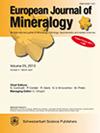阿拉维斯地块(法国上萨瓦)的极低品位层状硅酸盐和绿泥石中的二三八面体取代
IF 1.7
3区 地球科学
Q2 MINERALOGY
引用次数: 0
摘要
摘要在Aravis (Haute-Savoie, France)的不纯石灰岩块体中研究了极低品位的矿物矿脉,发现了丰富的矿物组合,以白云石、方解石、石英、云母、萤石和三种绿泥石为典型。脉网延伸超过5公里,可能位于石灰岩的掩埋峰附近(约7公里深,190°C)。用电子显微镜、质谱和x射线衍射研究了矿物学,重点是绿泥石类型。第一种绿泥石类型为绿泥石,常与伊利云母夹层。第二种是富镁贫铝的炊具。第三种类型为富锂苏多利岩。三种绿泥石类型的存在表明二三八面体绿泥石相组分(苏多石和库克石)和三三八面体绿泥石相组分(绿泥石)之间的溶解度有限。富锂苏多石和富镁炊事石偏离理想的端元组成,表明固溶体趋向于锂苏多石成分。伴生的云母不含大量的锂,但呈现叶蜡石和二三八面体取代,不含Tschermak成分。这些结果要求对绿泥石的Li含量进行系统的研究,并更好地模拟绿泥石和云母中的二三八面体取代。本文章由计算机程序翻译,如有差异,请以英文原文为准。
Very-low-grade phyllosilicates in the Aravis massif (Haute-Savoie, France) and the di-trioctahedral substitution in chlorite
Abstract. Very-low-grade mineral veins investigated in the impure limestone massif of the Aravis (Haute-Savoie, France) yielded a rich mineral assemblage typified by dolomite, calcite, quartz, illitic mica, fluorite and three types of chlorite. The vein network extends over more than 5 km and was probably emplaced around peak burial of the limestone (∼7 km depth, 190 ∘C). The mineralogy has been investigated with electron microscopy, mass spectrometry and X-ray diffraction, with emphasis on chlorite types. The first chlorite type is a chamosite often interlayered with illitic mica. The second type is a Mg-rich, Al-depleted cookeite. The third type is a Li-rich sudoite. Presence of the three chlorite types shows limited solubility between di-trioctahedral chlorite phase components (sudoite and cookeite) and with tri-trioctahedral chlorite (chamosite). Departure of the Li-rich sudoite and Mg-rich cookeite from the ideal end-member compositions suggests solid solutions towards a Li-sudoite component. The associated illitic mica does not contain Li in significant proportion but shows pyrophyllitic and di-trioctahedral substitution, without a Tschermak component. These results call for systematic studies of the Li content of chlorite and for better modelling of di-trioctahedral substitution in chlorite and mica.
求助全文
通过发布文献求助,成功后即可免费获取论文全文。
去求助
来源期刊
CiteScore
2.80
自引率
9.50%
发文量
40
审稿时长
6-12 weeks
期刊介绍:
EJM was founded to reach a large audience on an international scale and also for achieving closer cooperation of European countries in the publication of scientific results. The founding societies have set themselves the task of publishing a journal of the highest standard open to all scientists performing mineralogical research in the widest sense of the term, all over the world. Contributions will therefore be published primarily in English.
EJM publishes original papers, review articles and letters dealing with the mineralogical sciences s.l., primarily mineralogy, petrology, geochemistry, crystallography and ore deposits, but also biomineralogy, environmental, applied and technical mineralogy. Nevertheless, papers in any related field, including cultural heritage, will be considered.

 求助内容:
求助内容: 应助结果提醒方式:
应助结果提醒方式:


